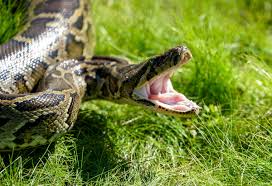“Uncoiling Disaster: How Irresponsible Pet Ownership Unleashed Burmese Pythons and Caused a Natural Catastrophe in Miami”
Animal enthusiasts worldwide have held a deep fascination with the idea of owning exotic pets for centuries. The world of exotic pets, with its captivating elegance in the form of Burmese pythons and the charismatic charm of sugar gliders, tantalizes with the promise of unique companionship. However, beneath the surface of this seemingly enchanting realm, a stark reality underscores the profound importance of responsibility in pet ownership. As we delve into the gripping story of how irresponsibility in the realm of pet ownership led to a natural catastrophe in Miami, it becomes abundantly clear that the actions of individuals who engage in pet ownership without the necessary knowledge and caution can result in disaster on a grand scale. The case of the Burmese pythons, whose unchecked proliferation in the subtropical wilds of Florida has wreaked havoc on the local ecosystem, serves as a powerful cautionary tale. It underscores the vital need for conscientiousness, education, and regulatory oversight in the realm of exotic pet ownership; lest we continue to inadvertently unleash environmental catastrophes of our own making.

Irresponsible pet ownership has undeniably played a significant and troubling role in the creation of a natural catastrophe in Miami, with Burmese pythons at the epicenter of this ecological disaster. This complex and ongoing crisis is a stark illustration of the far-reaching consequences of human actions when it comes to exotic pet ownership. In the heart of Miami, a disaster of monumental proportions was quietly unfolding, all stemming from the seemingly innocent allure of exotic pet ownership. Burmese pythons, initially cherished as exotic pets by irresponsible owners, found themselves thrust into a thriving subtropical habitat that mirrored their native Southeast Asian homeland. A convergence of factors, from a perfect climate to an abundance of prey, set the stage for a catastrophe that would echo for years to come.
Hurricane Andrew, which struck South Florida in August 1992, also had a significant impact on the issue of invasive species like Burmese pythons (Python bivittatus) in the region. While the hurricane itself did not directly introduce Burmese pythons into the ecosystem, many believe it played a role in initially introducing them to Florida. One theory is that the hurricane may have damaged or destroyed pet stores and exotic animal facilities in its path, leading to the escape or release of animals, including Burmese pythons, into the wild. The destruction caused by the hurricane could have facilitated the dispersal of these animals into the surrounding environment.
However, it is important to note that the introduction of Burmese pythons into Florida’s ecosystem was likely a result of multiple factors, including the pet trade, intentional releases by pet owners, and possibly events like Hurricane Andrew. The aftermath of Hurricane Andrew drew attention to the broader issue of invasive species in Florida and the potential ecological consequences of exotic pet ownership. It highlighted the need for responsible pet ownership and stricter regulations to prevent further introductions of non-native species into sensitive ecosystems. In response to this and other incidents involving exotic animals, there have been calls for enhanced regulations and responsibilities for pet stores, breeders, and exotic animal dealers. These efforts aimed to prevent further escapes or releases of potentially harmful or invasive species and to promote responsible pet ownership.


These non-native Burmese pythons, characterized by their massive frames and insatiable appetites, rapidly reproduced at an astonishing rate. As they roamed freely in the wild, they encountered an ecosystem lacking natural predators, unable to cope with their presence. These pythons, opportunistic feeders with a preference for birds, mammals, and reptiles, initiated an unremitting attack on Miami’s indigenous wildlife. Their uncontrolled predation resulted in catastrophic declines among local species. Some, unable to withstand this relentless onslaught, teetered dangerously on the brink of extinction. Small mammals like marsh rabbits and cotton rats, roughly the size of rabbits, have suffered severe predation by Burmese pythons, leading to population declines. Ground-nesting birds, such as the American woodcock and the eastern meadowlark, have also been vulnerable to python predation, with both adult birds and their eggs falling prey. Native reptiles, including various species of snakes, lizards, and turtles, have not escaped the impact, facing python predation as well. Amphibians, exemplified by the eastern narrow-mouthed toad, have also seen declines due to their encounters with these invasive snakes. Even endangered species like the Key Largo woodrat are under significant threat in the presence of Burmese pythons in their habitats. The full extent of the impact on these species and others is still under investigation, but efforts to address and mitigate the ecological damage caused by these invasive pythons are ongoing.
Miami’s geographic location and subtropical climate create an ideal habitat for Burmese pythons. The warm, humid conditions mimic the snakes’ natural range, providing them with a comfortable home where they thrive. This environmental congruence, coupled with an abundant food supply, facilitates their rapid colonization and reproduction. One of the critical factors contributing to the Burmese python catastrophe is the absence of natural predators in Florida’s ecosystem. These snakes do not evolve alongside the native flora and fauna, meaning they enter an environment where they face little to no natural checks on their population growth. Unlike their natural habitat where they contend with large predators and other ecological pressures, in Florida, they encounter an environment where they become apex predators. Furthermore, Burmese pythons are notorious for being opportunistic feeders. Their dietary preferences range from birds and mammals to other reptiles. This adaptability allows them to exploit a wide range of potential prey, which further exacerbates the impact on the local wildlife.


Alligators and crocodiles are indeed predators in the Everglades and other parts of Florida, but they have limited interaction with Burmese pythons and do not effectively control the python population. This is because they inhabit primarily aquatic environments like swamps, marshes, and water bodies, while Burmese pythons are highly adaptable and often found in various terrestrial habitats. These differences in habitat preferences reduce the chances of direct interactions between these species. Additionally, adult Burmese pythons can reach sizes that often exceed those of alligators and crocodiles found in the same region, making them less vulnerable to predation. While there are occasional reports of alligators and crocodiles preying on Burmese pythons, such interactions are infrequent, and pythons do not form a significant part of their diets. These factors contribute to the challenge of using alligators and crocodiles as natural predators to control the Burmese python population in the Everglades.
The disaster extends beyond the ecological realm, encompassing other significant dimensions. The economic impact is palpable. Tourism, which thrived on the region’s unique wildlife and natural beauty, began to wane as the once-diverse ecosystem diminished. Agriculture, too, suffers as pythons prey on livestock and damaged crops, causing financial losses that ripples through local businesses. Perhaps most chillingly, the presence of these colossal snakes began to encroach on human lives. Encounters with Burmese pythons are not just scary; they became potentially deadly. While these snakes are not typically a direct danger to humans, reports emerge of dangerous encounters, even fatalities, as the invasive pythons venture closer to populated areas. The financial and logistical burden of addressing this catastrophe falls squarely on the shoulders of government agencies, wildlife organizations, and taxpayers. Intensive python removal programs, educational initiatives, and research efforts demand substantial resources. Despite these efforts, the catastrophe persists, and its long-term consequences loom ominously. The Burmese python invasion in Miami is a stark reminder of the dire consequences of irresponsible pet ownership. It highlights the urgent need for strict regulations, public awareness, and conservation efforts to prevent similar ecological and societal disasters in the future.


Efforts to combat the Burmese python catastrophe in Florida are multifaceted and ongoing. Government agencies like the Florida Fish and Wildlife Conservation Commission (FWC) spearhead python removal programs. These initiatives employ trained individuals to capture and remove pythons from the wild. Incentives and bounties available for successful captures. Scientists and researchers actively study python behavior, ecology, and habitat use. This research informs management strategies and helps track the effectiveness of control efforts. Public awareness campaigns and educational initiatives aim to inform residents and visitors about the ecological impact of Burmese pythons and the importance of responsible pet ownership. The FWC and other organizations conduct outreach programs to raise awareness. Stricter regulations on the possession, sale, and transportation of Burmese pythons and other invasive species are in place. These regulations aim to prevent further introductions and limit the pet trade in potentially invasive species. Some efforts employ technology like tracking devices to locate and monitor pythons, aiding in control efforts. Managed hunting programs allow licensed hunters to assist in python removal, although strict guidelines ensure humane treatment and ethical hunting practices. Ongoing research focuses on developing methods for sterilizing male pythons. The goal is to release sterile males into the wild to disrupt the breeding cycle and reduce the python population. Additionally, scientists explore the possibility of using biological controls, such as parasites or diseases, to target pythons. The challenge of controlling the Burmese python population remains significant due to their adaptability and vast, remote habitats. Nonetheless, the dedication of researchers, wildlife agencies, and the public is crucial in managing and mitigating this ecological catastrophe.
Florida Fish and Wildlife Conservation Commission (FWC): The FWC is at the forefront of python removal and management efforts in Florida. They often have programs for python removal and may offer training for volunteers. You can visit their website at https://myfwc.com/ or contact them directly at (850) 488-4676 for information on how to get involved.






